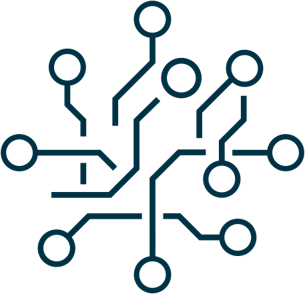In the digital era of quick swipes, attention has become a scarce resource. Today, information must not only be correct; above all, it must be comprehensible at a glance and appealing to the eye. Traditional information platforms with walls of text and menus quickly lose the audience's interest. The challenge lies in designing even complex content in a way that readers can get a first grasp of it in seconds and delve deeper if so desired.
Don't read, experience
The more precisely digital interfaces reflect our real world, the easier it is to interact with them. This is exactly where experience-oriented applications come into play: They create environments that can be experienced without any explanation. Instead of abstract menus and clickable tiles, users explore digital spaces they can understand intuitively.
Be it a production hall with visualized energy flows or a training company with a wide variety of job profiles: the content is not only conveyed but made tangible. This creates a memorable impression and an emotional connection to the topic.
Probably the best-known representatives of experience-oriented user guidance are virtual and augmented reality applications.
Less effort, valuable result
But the advantages of immersive applications can also be gained without VR goggles and with manageable effort. For example, a digital 3D world created for a company in the infrastructure, energy, and education sector can present such topics as living space design and vocational training in a very engaging way.
The virtual environment is based on familiar structures such as village centers, residential areas, and commercial facilities. This makes it easy for users to get started. Instead of clicking through menus, they navigate through this virtual world where content appears where it would be expected in real life.
The application runs on smartphones, laptops, large screens, or an interactive table at trade fairs. It is suitable wherever people need to engage with complex topics in a playful way.
The following table compares the classic tile-based display with the experience-oriented screen presentation and lists their features:
|
Tiles, menus, diagrams
|
Experience-oriented application on screen
|
| Users must make connections themselves | Shows connections through spatial relations |
| Visual structure is often abstract | Visual and intuitive like a real-life environment |
| Information is arranged horizontally | Information is interlinked |
| Requires explanation or training | Can be used without prior knowledge |
| Can cause unmanageable demands and fear of contact | Sparks curiosity and encourages engagement |
| Looks cold and distant | Exudes liveliness and emotions |
| Feels like work | Feels like playful discovery |
|
Mixed reality table
|
|
| Lowers the interaction threshold even more than a desktop application | |
| Is an even stronger eye-catcher | |
| Promotes collaborative exploring as a group | |
| Enables familiar interaction through the real handling of objects |
Interaction with the mixed-reality table Lusee
Who can benefit from developing an immersive application?
An immersive application can be used in multiple scenarios that go far beyond pure visualization:
| Topic | Examples | Suitability / Use of an immersive application |
| Trade fair and event communication |
Interactive model of a digital government agency, walk-in insurance world, logistics scenarios | Attracting attention, sparking emotions, making services understandable |
| Knowledge transfer | Financial product training, introduction into regulatory requirements, explaining technologies, sustainability of supply chains | Explaining complex content visually, orienting employees and customers that lack prior knowledge |
| Stakeholder communication | Communication in infrastructure projects, introduction of new services | Creating transparency, promoting engagement, strengthening trust through clarity |
| Behavior control / Awareness | Cybersecurity awareness, CO₂ footprint in logistics, energy consumption of public buildings | Making the impact of individual action tangible, promoting a sense of responsibility |
| Process monitoring and control | Supply chain monitoring, network or traffic control | Detecting problems early, providing clear status overviews, being able to classify live data |
| Scenario thinking and simulations of the future | Simulations of market behavior, risk scenarios in civil protection, supply chain disruptions | Simulating future scenarios in an understandable way, strengthening decision-making basis |
| Product and services explanation | Digital financial products (e.g., mortgages), insurance models, logistics solutions for SMEs | Clearly communicating benefits, creating trust, supporting decision-making |
Thinking ahead – a glimpse into the future reality
Subconscious training in the digital twin
Immersive applications will continue to develop, for example in the following direction:
Let's imagine that the digital control system of an industrial plant maps both processes and the physical space. Anyone who activates a valve in the virtual representation also can see where it is located in the real environment – not just abstractly on a schematic but also embedded in the familiar surroundings. Users are thus subconsciously trained for emergencies when the technology fails and manual knowledge is required on site.

Limits and challenges
As impressive as experience-oriented applications are, they are not a panacea. The following aspects should be taken into account for such applications to bring added value:
- The content is the priority: The subject matter you want to communicate must never take a back seat.
- Specialist knowledge is required: A convincing implementation requires additional expertise – for example in the areas of technology, usability, and content creation.
- Technically more demanding: Compared to traditional applications, immersive experiences require significantly more computing power, which can overwhelm older devices.
- Higher development effort: Concept, design, and implementation are more complex and require more time and resources.
- Not everything can be made immersive: Not all content is suitable for such a presentation – and not all target groups benefit equally from this approach.
A touchpoint with a long-term effect
A company that is prepared to embrace immersive applications despite their challenges and limitations opens up a new level of communication – one that creates an intuitive entry point for everybody and conveys complex content in a sustainable way.






